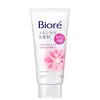What's inside
What's inside
 Key Ingredients
Key Ingredients

 Benefits
Benefits

 Concerns
Concerns

 Ingredients Side-by-side
Ingredients Side-by-side

Water
Skin ConditioningCellulose
AbsorbentButylene Glycol
HumectantDipropylene Glycol
HumectantAlcohol Denat.
AntimicrobialGlycerin
HumectantBetaine
Humectant1,2-Hexanediol
Skin ConditioningMicrocrystalline Cellulose
AbsorbentPPG-13-Decyltetradeceth-24
EmulsifyingAcrylates/C10-30 Alkyl Acrylate Crosspolymer
Emulsion StabilisingParfum
MaskingPotassium Hydroxide
BufferingEthylhexylglycerin
Skin ConditioningDisodium EDTA
Trehalose
HumectantPrunus Mume Fruit Extract
HumectantGlycolic Acid
BufferingSucrose
HumectantDextrin
AbsorbentTheobroma Cacao Extract
Skin ConditioningLactobacillus Ferment Lysate Filtrate
Skin ConditioningPrunus Mume Flower Extract
Skin ConditioningPropanediol
SolventRosa Canina Fruit Extract
AstringentTocopherol
AntioxidantPhenoxyethanol
PreservativeIndole Acetic Acid
Skin ConditioningWater, Cellulose, Butylene Glycol, Dipropylene Glycol, Alcohol Denat., Glycerin, Betaine, 1,2-Hexanediol, Microcrystalline Cellulose, PPG-13-Decyltetradeceth-24, Acrylates/C10-30 Alkyl Acrylate Crosspolymer, Parfum, Potassium Hydroxide, Ethylhexylglycerin, Disodium EDTA, Trehalose, Prunus Mume Fruit Extract, Glycolic Acid, Sucrose, Dextrin, Theobroma Cacao Extract, Lactobacillus Ferment Lysate Filtrate, Prunus Mume Flower Extract, Propanediol, Rosa Canina Fruit Extract, Tocopherol, Phenoxyethanol, Indole Acetic Acid
Water
Skin ConditioningSorbitol
HumectantMyristic Acid
CleansingLauryl Hydroxysultaine
CleansingLaureth-4 Carboxylic Acid
Ethylhexylglycerin
Skin ConditioningCellulose
AbsorbentZea Mays Starch
AbsorbentPotassium Hydroxide
BufferingLaureth-6 Carboxylic Acid
CleansingLauric Acid
CleansingMagnesium Potassium Fluorosilicate
AbrasiveSodium Ma/Vinyl Alcohol Copolymer
Palmitic Acid
EmollientParfum
MaskingPolyquaternium-7
Acrylates/C10-30 Alkyl Acrylate Crosspolymer
Emulsion StabilisingDisodium EDTA
PEG-6
HumectantPolyquaternium-39
PEG-65m
Emulsion StabilisingArginine
MaskingBentonite
AbsorbentBetaine
HumectantBHT
AntioxidantPhenoxyethanol
PreservativeSodium Benzoate
MaskingCI 77491
Cosmetic ColorantCI 77891
Cosmetic ColorantWater, Sorbitol, Myristic Acid, Lauryl Hydroxysultaine, Laureth-4 Carboxylic Acid, Ethylhexylglycerin, Cellulose, Zea Mays Starch, Potassium Hydroxide, Laureth-6 Carboxylic Acid, Lauric Acid, Magnesium Potassium Fluorosilicate, Sodium Ma/Vinyl Alcohol Copolymer, Palmitic Acid, Parfum, Polyquaternium-7, Acrylates/C10-30 Alkyl Acrylate Crosspolymer, Disodium EDTA, PEG-6, Polyquaternium-39, PEG-65m, Arginine, Bentonite, Betaine, BHT, Phenoxyethanol, Sodium Benzoate, CI 77491, CI 77891
Ingredients Explained
These ingredients are found in both products.
Ingredients higher up in an ingredient list are typically present in a larger amount.
Acrylates/C10-30 Alkyl Acrylate Crosspolymer is a synthetic polymer. It is used to thicken and improve the texture of products. Due to its properties, it can prevent water and oil ingredients from separating.
Betaine is a common humectant (a substance that promotes retention of moisture). It's known to be gentle on the skin and can help balance hydration.
This ingredient is best for improving hydration and soothing irritated skin. Studies also show it helps even out skin tone.
Fun fact: Betaine is naturally created in the skin and body. The kind found within cosmetic products can be either plant-derived or synthetic.
Another name for betaine is trimethylglycine.
Learn more about BetaineCellulose is the main component of plant cell walls. It is used as an emulsifier, absorbent, and texture enhancer.
This ingredient has many functions:
Fun fact: Cellulose is the most abundant form of organic polymer on Earth.
Learn more about CelluloseDisodium EDTA plays a role in making products more stable by aiding other preservatives.
It is a chelating agent, meaning it neutralizes metal ions that may be found in a product.
Disodium EDTA is a salt of edetic acid and is found to be safe in cosmetic ingredients.
Learn more about Disodium EDTAEthylhexylglycerin (we can't pronounce this either) is commonly used as a preservative and skin softener. It is derived from glyceryl.
You might see Ethylhexylglycerin often paired with other preservatives such as phenoxyethanol. Ethylhexylglycerin has been found to increase the effectiveness of these other preservatives.
Parfum is a catch-all term for an ingredient or more that is used to give a scent to products.
Also called "fragrance", this ingredient can be a blend of hundreds of chemicals or plant oils. This means every product with "fragrance" or "parfum" in the ingredients list is a different mixture.
For instance, Habanolide is a proprietary trade name for a specific aroma chemical. When used as a fragrance ingredient in cosmetics, most aroma chemicals fall under the broad labeling category of “FRAGRANCE” or “PARFUM” according to EU and US regulations.
The term 'parfum' or 'fragrance' is not regulated in many countries. In many cases, it is up to the brand to define this term.
For instance, many brands choose to label themselves as "fragrance-free" because they are not using synthetic fragrances. However, their products may still contain ingredients such as essential oils that are considered a fragrance by INCI standards.
One example is Calendula flower extract. Calendula is an essential oil that still imparts a scent or 'fragrance'.
Depending on the blend, the ingredients in the mixture can cause allergies and sensitivities on the skin. Some ingredients that are known EU allergens include linalool and citronellol.
Parfum can also be used to mask or cover an unpleasant scent.
The bottom line is: not all fragrances/parfum/ingredients are created equally. If you are worried about fragrances, we recommend taking a closer look at an ingredient. And of course, we always recommend speaking with a professional.
Learn more about ParfumPhenoxyethanol is a preservative that has germicide, antimicrobial, and aromatic properties. Studies show that phenoxyethanol can prevent microbial growth. By itself, it has a scent that is similar to that of a rose.
It's often used in formulations along with Caprylyl Glycol to preserve the shelf life of products.
Potassium hydroxide is commonly known as caustic potash. It is used to fix the pH of a product or as a cleaning agent in soap. In cleansers, it is used for the saponification of oils.
Sapnification is the process of creating fatty acid metal salts from triglycerides and a strong base. During this process, Potassium Hydroxide is used up and is not present in the final product.
Using high concentrations of Potassium Hydroxide have shown to irritate the skin.
Learn more about Potassium HydroxideWater. It's the most common cosmetic ingredient of all. You'll usually see it at the top of ingredient lists, meaning that it makes up the largest part of the product.
So why is it so popular? Water most often acts as a solvent - this means that it helps dissolve other ingredients into the formulation.
You'll also recognize water as that liquid we all need to stay alive. If you see this, drink a glass of water. Stay hydrated!
Learn more about Water